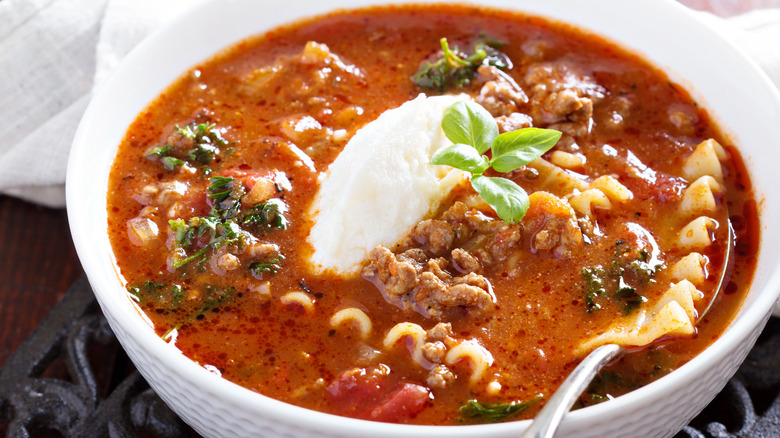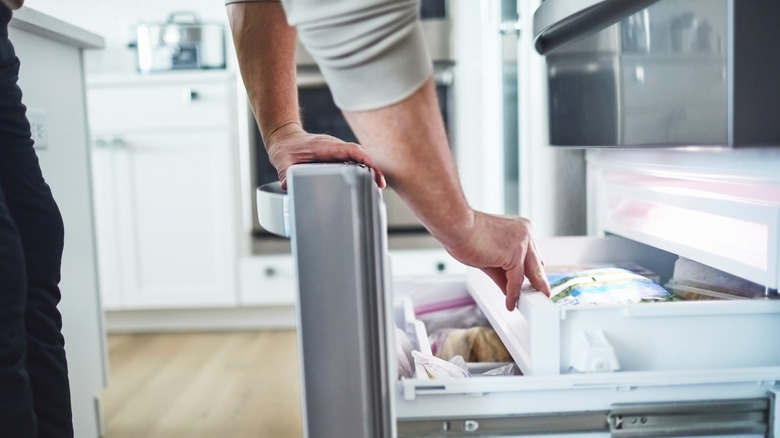What To Know Before You Freeze Lasagna Soup
Dense with savory ground meat, rich, creamy cheeses, and herb-kissed tomato sauce, what could be better than a heaping tray of lasagna? Lasagna soup, of course. A deconstructed version of the classic pasta casserole, lasagna soup is a spoonable take on an Italian classic that delivers the same bold flavors in a more laid-back yet equally satisfying form. Although it's a delicious and relatively easy-to-make dish for a stress-free weeknight meal, you might need to prepare lasagna soup for later enjoyment. Whether you're readying a dish for an upcoming potluck or enjoy the convenience of meal prepping, freezing lasagna soup guarantees a comforting dish that's ready to heat and serve on the fly. Here's what you need to know beforehand.
The first step is to cook your ground meat and tomato sauce-tinted broth with the veggies and aromatics of your choosing, but omit the noodles and cheese as they can develop undesirable textures when thawed from frozen. An airtight container is crucial for storage to prevent the soup from becoming exposed to air, moisture, or any particles in your freezer that could degrade the dish's quality. Mason jars, lidded food containers, or resealable plastic bags are great options. Ideally, your freezer should be set to 0 degrees Fahrenheit to properly freeze the soup for complete preservation of flavor and freshness.
How long does frozen lasagna soup last?
Freezing food of any type — soup or otherwise — significantly extends its shelf life. But just how long does frozen lasagna soup last in the freezer?
To determine how long your frozen lasagna soup will stay fresh, you need to consider the specific type of ingredients. Because ground meat, vegetables, and broth have varying shelflifes, your frozen soup will only last as long as the ingredient with the shortest lifespan. For example, ground red meat and poultry can last up to four months in the freezer, but frozen vegetable broth can last up to eight months. So, in this case, you should only keep your soup in the freezer for four months.
From a food safety perspective, frozen food never spoils to a degree where it would become unsafe to eat. The biggest concerns with frozen food are freezer burn and not-so-appetizing changes in texture and flavor. Lasagna soup is creamy, smooth, and flavorful, so reheating it from frozen after one too many months will compromise these defining characteristics.
Reheating lasagna soup
Texture and flavor are everything when it comes to crafting a high-quality lasagna soup, so be careful when reheating it so you can enjoy it as if it were freshly made. But cooking it is the tricky part; re-heating it is easy. By remembering a few simple tips, you can seamlessly take lasagna soup from frozen to hot.
Although you can reheat the soup straight from the freezer, you'll achieve a better texture by thawing it overnight in the refrigerator. Because you have more control over the temperature and are more likely to achieve an even warmth throughout the dish, reheating lasagna soup on a stovetop is preferred over microwaving. Often, microwaved food is piping hot in one bite and frosty the next, and it can also degrade the textural quality of a dish; so, save your microwave for popcorn and fire up the stovetop instead. Pro tip: A drizzle or spritz of cooking oil before heating the soup can prevent the ingredients from sticking together and clinging to the pot.
Although the appeal to freezing lasagna soup lies in time-sensitive convenience, you will still need to introduce two key ingredients: noodles and cheese. Once your lasagna soup is simmering, introduce the sheet noodles and cook them until al dente. Once everything is thoroughly heated and the noodles are finished cooking, serve it in your favorite soup bowl and garnish with a luscious dollop of ricotta cheese. Et voilà — meal-prepped lasagna soup for any occasion.


